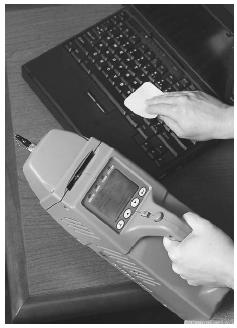Chemical and Biological Detection Technologies

█ BRIAN HOYLE
The ability to detect the components of chemical and biological weapons is an important part of a national security strategy. For example, the inability to rapidly detect letters for the presence of anthrax spores provided a route for the targeting of infectious microorganisms in the United States in 2001. The portability of chemical and biological weapons has made them attractive to individuals or groups with political, religious, or other grievances. This has spurred development of more sophisticated, accurate and rapid detection technologies.
The conventional x-ray technology long used in airports has been refined. Most of the x-ray beam is reflected back immediately upon encountering an object. Some of the radiation, however, passes through the object. By analyzing the beams that actually penetrate through an object, information on the object's composition is provided. Another version sends two different x rays of different wavelengths through an object. The different beams can distinguish between organic objects, such as food and paper, and inorganic objects.
A chemical detection technology known as gas chromatography has been sped into routine use in airports since the U.S. terrorist attacks of September 11, 2001. The different chemicals present on a cloth that is swiped over an object can be separated based on their different preference for the gas mixture that is pumped through the sample chamber. A target chemical (i.e., an explosive) is detected within seconds.
Chemical detection technologies have also been adapted for use "in the field", such as by United Nations inspectors deployed in Iraq beginning in November 2002, to the presence of missiles that were supposedly destroyed by the Iraqi government in the mid-1990s.
Sound can be used to detect chemicals. For example, the acoustic wave sensor uses a quartz surface to convert incoming sound waves into electrical signals. Over a dozen different chemicals can be detected within seconds, even from biological sources. In another sound-based technique called acoustic resonance, the pattern of vibrations when sound waves are sent inside an object like a missile can reveal whether the missile is filled with a solid or a liquid, and even the type of chemical present.
Light is another means of chemical detection. The use of light is called spectroscopy. Mass spectroscopy determines the mass of proteins, which is important in determining the identity of the chemical or biological agent. Matrix-Assisted Laser Desorption/Ionization Mass Spectroscopy (MALDI-MS) can identify proteins that are unique to Bacillus anthracis (the cause of anthrax) and Yersinia pestis (the cause of plague). Raman spectroscopy measures the change in the wavelength of a light beam by the sample molecules. Optical spectroscopy measures the absorption of light by the chemical groups and the subsequent emission of light by the same groups as the identification method.
The ability to detect genetic sequences that are unique to certain bacteria (gene probing) has been exploited to develop genetically based microbial detection methods. The best example of gene probing is the polymerase chain reaction (PCR), which can enzymatically detect a target stretch of genetic material and rapidly amplify that region to detectable levels. Handheld PCR detectors (i.e., Handheld Advanced Nucleic Acid Analyzer, or HANAA) were used in the 2002–2003 inspections of Iraqi facilities by United Nations officials.
Biological detection devices can monitor the surrounding air at regular intervals. Air is automatically drawn into the device and analyzed for target genetic sequences using the PCR technology. The results can be electronically relayed to a central base for analysis.
Another biological technology utilizes antibodies that are produced in response to the presence of a specific microorganism. Tests are available that detect Bacillus anthracis , Clostridium botulinum , viruses (e.g., smallpox), and chemicals (e.g., ricin) in minutes.
Some older biological detection technologies still prove reliable. Growth of microorganisms on artificial food sources (media) produces populations called colonies. Medium can be selected that produces colonies that have a distinctive appearance and color. Gel electrophoresis separates differently sized pieces of genetic material or other microbial components (e.g., protein) into bands. The banding pattern can be used to identify the microorganism. Finally, chromatography separates compounds from one another based on their differing speed of movement through a gas or a liquid mixture.
█ FURTHER READING:
BOOKS:
Cilluffo, Frank J., Sharon L. Cardash, and Gordon Nathaniel Lederman. Combating Chemical, Biological, Radiological, and Nuclear Technologies: A Comprehensive Strategy: A Report of the Csis Homeland Defense Project. Washington, D.C.: Center for Strategic and International Studies, 2001.
Fritz, Sandy, and Jack Brown. Understanding Germ Warfare (Science Made Accessible). New York: Warner Books, 2002.
Lederberg, Joshua, and William S. Cohen. Biological Weapons: Limiting the Threat (BCSIA Studies in International Security). Boston: MIT Press, 1999.
United States Department of Defense. 21st Century Bioterrorism and Germ Weapons: U.S. Army Field Manual for the Treatment of Biological Warfare Agent Casualties (Anthrax, Smallpox, Plague, Viral Fevers, Toxins, Delivery Methods, Detection, Symptoms, Treatment, Equipment). Washington, D.C.: Progressive Management, 2001.
Comment about this article, ask questions, or add new information about this topic: